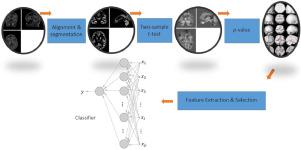Computer Methods and Programs in Biomedicine ( IF 4.9 ) Pub Date : 2020-10-15 , DOI: 10.1016/j.cmpb.2020.105793 Gabriel Solana-Lavalle , Roberto Rosas-Romero

|
Background and objectives: Qualitative and quantitative analyses of Magnetic Resonance Imaging (MRI) scans are carried out to study and understand Parkinson’s Disease, the second most common neurodegenerative disorder in people at their 60’s. Some quantitative analyses are based on the application of voxel-based morphometry (VBM) on magnetic resonance images to determine the regions of interest, within gray matter, where there is a loss of the nerve cells that generate dopamine. This loss of dopamine is indicative of Parkinson’s disease. The purpose of this research is the introduction of a new method to classify the 3-D magnetic resonance scans of an individual, as an assisting tool for diagnosis of Parkinson’s disease by using the largest MRI dataset (Parkinson’s Progression Markers Initiative) from a population of patients with Parkinson’s disease and control individuals. A contribution is that separate studies are conducted for men and women since gender plays a significant role within Neurobiology, which is demonstrated by the fact that men are more prone to Parkinson’s disease than women are.
Methods: Previous to classification, VBM is conducted on magnetic resonance images to detect the regions where features are extracted by using first- and second-order statistics methods. Furthermore, the number of features is considerably reduced by using feature selection techniques. Seven classifiers are used and we are conducting separate experiments for men and women.
Results: The best detection performance achieved in men is 99.01% of accuracy, 99.35% of sensitivity, 100% of specificity, and 100% of precision. The best detection performance achieved in women is 96.97% of accuracy, 100% of sensitivity, 96.15% of specificity, and 97.22% of precision. During classification of magnetic resonance images, the corresponding computational complexity is reduced since few features are selected.
Conclusions: The proposed method provides high performance as an assisting tool in the diagnosis of Parkinson’s disease, by conducting separate experiments in men and women. While previous works have focused their analysis to the striatum region of the brain (the largest nuclear complex of the basal ganglia), the proposed approach is based on analysis over the whole brain by looking for decreases of tissue thickness, with the consequence of finding other regions of interest such as the cortex.
中文翻译:

通过基于体素的形态计量学和机器学习对PPMI MRI扫描进行分类,以帮助诊断帕金森氏病
背景与目的:进行磁共振成像(MRI)扫描的定性和定量分析,以研究和了解帕金森氏病,帕金森氏病是60岁以下人群中第二常见的神经退行性疾病。一些定量分析是基于基于体素的形态计量学(VBM)在磁共振图像上的应用,以确定感兴趣的区域在灰质中,会产生多巴胺的神经细胞丢失。多巴胺的这种损失表明帕金森氏病。这项研究的目的是引入一种对个人的3-D磁共振扫描进行分类的新方法,作为通过使用最大的MRI数据集(帕金森氏病进展倡议)来诊断帕金森氏病的辅助工具。帕金森氏病患者和对照个体。一个贡献是,由于性别在神经生物学中起着重要作用,因此对男女分别进行了研究,这一事实证明了男人比女人更容易患帕金森氏病。
方法:在分类之前,对磁共振图像进行VBM,以使用一阶和二阶统计方法检测特征提取区域。此外,通过使用特征选择技术大大减少了特征的数量。使用了七个分类器,我们正在分别对男人和女人进行实验。
结果:男性获得的最佳检测性能为99.01%的准确性,99.35%的敏感性,100%的特异性和100%的准确性。女性获得的最佳检测性能为准确度为96.97%,灵敏度为100%,特异性为96.15%和准确度为97.22%。在磁共振图像分类期间,由于选择了很少的特征,因此降低了相应的计算复杂度。
结论:该方法通过对男性和女性进行单独的实验,提供了高性能的辅助诊断帕金森氏病的工具。尽管先前的研究将分析重点放在大脑的纹状体区域(基底神经节的最大核复合体)上,但提出的方法是基于对整个大脑的分析,通过寻找组织厚度的减小来进行,结果是发现了其他感兴趣的区域,例如皮质。











































 京公网安备 11010802027423号
京公网安备 11010802027423号